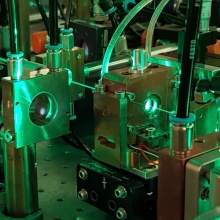Motivation
High-performance lasers have become indispensable in various material processing procedures. There are numerous applications that benefit from lasers in the visible spectral range. For instance, when welding copper, the use of green light is significantly more efficient due to its higher absorption (around 40%) compared to infrared light (around 3-5%).
However, currently, there are no laser active materials known that enable the direct generation of green laser radiation in the high-power range. Therefore, the approach of intra-cavity frequency doubling of infrared light is chosen.
Intracavity Frequency Doubling
Frequency doubling is a nonlinear optical process where two photons of the same frequency interact with a nonlinear material, producing a new photon with twice the frequency. Certain conditions, such as phase matching and crystal temperature, must be met for this process to occur.
Since this conversion process is highly sensitive to perturbations and the strong coupling between the optical and thermo-mechanical systems, adaptive optics and new control concepts are utilized to compensate disturbances and stabilize the conversion.
Adaptive Optics in the Resonator
Within the project, pneumatically actuated mirrors are used to compensate for wavefront distortions and adjust the beam radius at a specific location. A pressure chamber behind the mirror membrane allows controlling the mirror surface deformation. This deformation is predetermined by the thickness distribution of the membrane. Additionally, piezo-controlled mirror mounts are employed to achieve highly precise control of beam alignment.
Partner
Institut für Strahlwerkzeuge (IFSW), Universität Stuttgart
Contact

Stephanie Mrzyglod
M.Sc.Research Assistant



